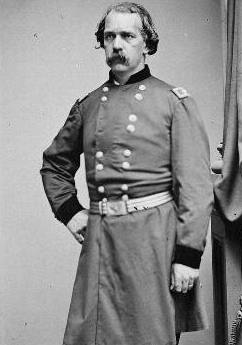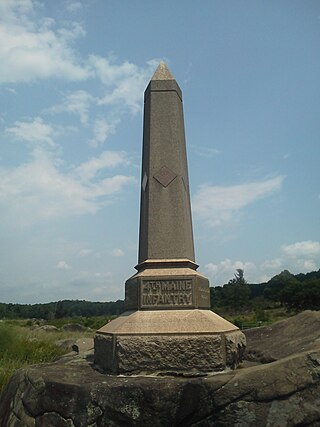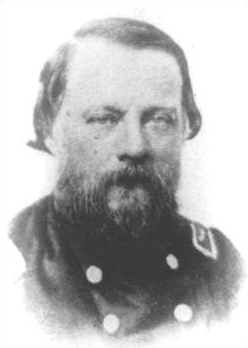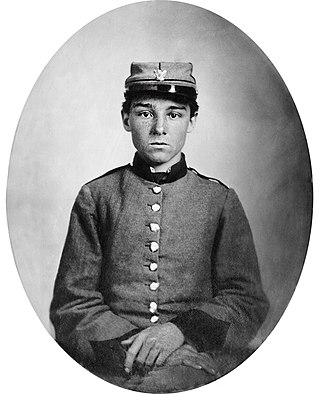The Irish Brigade was an infantry brigade, consisting predominantly of Irish Americans, who served in the Union Army in the American Civil War. The designation of the first regiment in the brigade, the 69th New York Infantry, or the "Fighting 69th," continued in later wars. The Irish Brigade was known in part for its famous war cry, the "Faugh a Ballaugh" which is an anglicization of the Irish phrase, fág an bealach, meaning "clear the way" and used in various Irish-majority military units founded due to the Irish diaspora. According to Fox's Regimental Losses, of all Union army brigades, only the 1st Vermont Brigade and Iron Brigade suffered more combat dead than the Irish Brigade during America's Civil War.

There were five corps in the Union Army designated as II Corps during the American Civil War. These formations were the Army of the Cumberland II Corps commanded by Thomas L. Crittenden from October 24, 1862, to November 5, 1862, later renumbered XXI Corps; the Army of the Mississippi II corps led by William T. Sherman from January 4, 1863, to January 12, 1863, renumbered XV Corps; Army of the Ohio II Corps commanded by Thomas L. Crittenden from September 29, 1862, to October 24, 1862, transferred to Army of the Cumberland; Army of Virginia II Corps led by Nathaniel P. Banks from June 26, 1862, to September 4, 1862, and Alpheus S. Williams from September 4, 1862, to September 12, 1862, renumbered XII Corps; and the Army of the Potomac II Corps from March 13, 1862, to June 28, 1865.

John Henry Hobart Ward was an American soldier who fought in the Mexican–American War and in the American Civil War. Ward joined the army in 1842 and fought in multiple battles in the Mexican–American war, including the Battle of Monterrey, where he was wounded. After leaving the army, he served successively as the assistant commissary general and commissary general for the state of New York. With the outbreak of the American Civil War in 1861, Ward rejoined the army, and became the colonel of the 38th New York Infantry Regiment. Ward and his regiment were engaged in the First Battle of Bull Run and in several battles in the Peninsula campaign. He was promoted to command a brigade after the Battle of Chantilly in September 1862.
The Philadelphia Brigade was a Union Army brigade that served in the American Civil War. It was raised primarily in the city of Philadelphia, Pennsylvania, with the exception of the 106th regiment which contained men from Lycoming and Bradford counties.
The 6th Georgia Infantry Regiment was an infantry regiment in the Confederate States Army during the American Civil War. It was organized at Macon, Georgia, in April 1861.

The Texas Brigade was an infantry formation of the Confederate Army that distinguished itself in the American Civil War. Along with the Stonewall Brigade, they were considered the Army of Northern Virginia's shock troops. It fought in every major battle of the Eastern Theater except Chancellorsville.

The 5th Michigan Infantry Regiment was an infantry regiment from Michigan that served in the Union Army during the American Civil War. The regiment was mustered into federal service in August 1861 and served in the Eastern Theater. It fought in all the major battles of the Army of the Potomac, including Seven Pines, the Seven Days Battles, Second Bull Run, Chantilly, Antietam, Fredericksburg, Chancellorsville, Gettysburg, the Wilderness, Spotsylvania, Cold Harbor, Petersburg, and Appomattox. The regiment was mustered out in June 1865.

The 1st New York Infantry Regiment was an infantry regiment that served in the Union Army during the American Civil War.

The 2nd New York Infantry Regiment was an infantry regiment that served in the Union Army during the American Civil War. It is also known as the Troy Regiment.

The 4th Maine Infantry Regiment was assembled in Rockland, Maine, on By May 20, 1861, with Colonel Hiram G. Berry as its commanding officer. He received four Knox County companies, one from Searsport, Winterport, Wiscasset, and Damariscotta, and two from Belfast. In all, 1,085 men, including a regimental band, were mustered. The regiment was mustered out of service July 19, 1864, with the expiration of their term. The veteran volunteers and recruits were transferred to 19th Maine Infantry. Of the 1440 men that served in the regiment during the war 170 men were killed in action or died of wounds received in battle. An additional 443 were wounded, 137 men perished of disease, and 40 men expired in Confederate prisons.

The 18th Georgia Infantry Regiment was an infantry regiment in the Confederate Army during the American Civil War. Originally brigaded with the three Texas regiments of John Bell Hood's Texas Brigade, it was transferred to Thomas R.R. Cobb's Georgia Brigade after the Battle of Antietam in late 1862. After General Cobb was mortally wounded at the Battle of Fredericksburg, the original colonel of the 18th Georgia, William T. Wofford, became Brigadier General of the Georgia Brigade.

The 140th New York Infantry Regiment was a volunteer infantry regiment that was created on September 13, 1862, for the Union Army during the American Civil War. From January 1864 they wore a Zouave uniform.
Irish-American Catholics served on both sides of the American Civil War (1861–1865) as officers, volunteers and draftees. Immigration due to the Irish Great Famine (1845–1852) had provided many thousands of men as potential recruits although issues of race, religion, pacifism and personal allegiance created some resistance to service. A significant body of these veterans later used the military experience gained in the war to launch several conflicts with the goal of establishing an independent Irish Republic as members of the Irish Republican Brotherhood, the Fenian Brotherhood and Clan na Gael.

The 67th New York Infantry Regiment was a regiment of the Union Army, which was raised in the city of Brooklyn in 1861 at the beginning of the American Civil War.

The 27th New York Infantry Regiment was an infantry regiment formed in Elmira, New York, to fight and defend the United States during the American Civil War. The regiment was also known as the "Union Regiment".

The 61st New York Infantry Regiment, also known as the "Astor Regiment", was an infantry regiment of the Union Army during the American Civil War.

The 72nd New York Infantry Regiment was one of five infantry regiments formed by former U.S. Congressman Daniel Sickles and established as part of the Excelsior Brigade which fought with the Union Army during multiple key engagements of the American Civil War, including the Chancellorsville Campaign in Virginia, the Battle of Gettysburg in Pennsylvania, and the Overland Campaign. Leaders from the 72nd New York recruited men from New Jersey, as well as from cities and small towns across the State of New York.

The 1st Louisiana Infantry Regiment was a unit of volunteers recruited in Louisiana that fought in the Confederate States Army during the American Civil War. Formed in April 1861, the regiment was sent to fight in the Eastern Theater of the American Civil War. Joining a brigade of Louisiana regiments, it fought at Malvern Hill, Second Bull Run, Antietam, and Fredericksburg in 1862, at Chancellorsville, Second Winchester, Gettysburg, and Mine Run in 1863, and at the Wilderness, Spotsylvania, Monocacy, Third Winchester, Fisher's Hill, Cedar Creek, and Petersburg in 1864, and at Appomattox in 1865. At Appomattox, the regiment was only a shadow of its former self.

The 2nd Louisiana Infantry Regiment was a unit of volunteers recruited in Louisiana that fought in the Confederate States Army during the American Civil War. Formed in May 1861, the regiment was sent to fight in the Eastern Theater of the American Civil War. Its first action took place during the Siege of Yorktown. The regiment suffered very heavy losses at Malvern Hill. After joining an all-Louisiana brigade, it fought at Cedar Mountain, Second Bull Run, Antietam, and Fredericksburg in 1862, at Chancellorsville, Second Winchester, Gettysburg, and Mine Run in 1863, and at the Wilderness, Spotsylvania, Cold Harbor, Monocacy, Third Winchester, Fisher's Hill, Cedar Creek, and Petersburg in 1864, and at Appomattox in 1865. The regiment lost over 100 men at both Second Bull Run and Chancellorsville. A company-sized remnant surrendered at Appomattox.

The 7th Louisiana Infantry Regiment was a unit of volunteers recruited in Louisiana that fought in the Confederate States Army during the American Civil War. Formed in June 1861, the regiment was sent to fight in the Eastern Theater of the American Civil War. After fighting at First Bull Run, the unit joined the 1st Louisiana Brigade. The regiment served in Jackson's Valley campaign and at Gaines' Mill, Malvern Hill, Cedar Mountain, Second Bull Run, Harpers Ferry, Antietam, and Fredericksburg in 1862. The regiment fought at Chancellorsville, Second Winchester, and Gettysburg in 1863. At Rappahannock Station in November 1863, almost the entire regiment was captured. The remnant of the unit fought at the Wilderness, Spotsylvania, Cold Harbor, and the Valley campaigns of 1864. It served at Petersburg starting in December 1864 and surrendered at Appomattox in April 1865.










